Sri Lanka, the teardrop-shaped island in the Indian Ocean, may be small in size but it’s incredibly rich in biodiversity. With landscapes ranging from misty mountains to arid plains and coastal wetlands, this tropical paradise boasts an impressive network of national parks that protect its unique ecosystems. Best part is most of these parks are easily accessible from the capital, Colombo itself.
Whether you’re a wildlife enthusiast, a nature photographer, or simply someone seeking adventure in pristine natural settings, Sri Lanka’s national parks offer unforgettable experiences. In this comprehensive guide, I’ll take you through the Sri Lanka’s Top 10 National Parks, revealing what makes each one special and how to get the most out of your visit.
Contents
- Introduction to Sri Lanka’s Natural Wonders
- 1) Yala National Park
- 2) Wilpattu National Park
- 3) Udawalawe National Park
- 4) Minneriya National Park
- 5) Horton Plains National Park
- 6) Bundala National Park
- 7) Wasgamuwa National Park
- 8) Gal Oya National Park
- 9) Kumana National Park
- 10) Maduru Oya National Park
- Practical Guide to Visiting Sri Lanka’s National Parks
- Conservation Challenges and Responsible Tourism
- Conclusion
- FAQs About Sri Lanka’s National Parks
- 1. When is the best time of year to visit Sri Lanka’s national parks?
- 2. Do I need to book national park safaris in advance?
- 3. What should I pack for a Sri Lankan national park visit?
- 4. Is it possible to see leopards in Sri Lanka’s national parks?
- 5. Are Sri Lanka’s national parks suitable for children?
- Related posts:
- Top 11 Things To Do in Nuwara Eliya, Sri Lanka
- The Ultimate Sri Lanka Travel Guide
- When to Visit Masai Mara for the Best Safari Experience
- 10 Must Visit Places in Sri Lanka
- The Ultimate Andaman & Nicobar Islands Travel Guide
- The Best Road Trips in Sri Lanka
- African Safari: Kenya's Top National Parks and their Unique Animals
- Top 12 Things To Do In Colombo- The Absolute Itinerary
Introduction to Sri Lanka’s Natural Wonders
The Ecological Significance of Sri Lankan National Parks
Sri Lanka’s national parks serve as crucial safe havens for countless species, including the endangered Sri Lankan elephant, the elusive Sri Lankan leopard (a distinct subspecies), and the rare sloth bear. These protected areas play vital roles in conservation efforts, scientific research, and sustainable tourism development.
The Department of Wildlife Conservation manages these parks with increasing focus on balancing tourism needs with ecological preservation. Each entry fee you pay contributes directly to conservation initiatives, making your visit part of the solution to protecting these invaluable ecosystems.
Biodiversity Hotspots in the Pearl of the Indian Ocean
Sri Lanka is recognized as one of the world’s 36 biodiversity hotspots, with its varied climate zones creating distinct habitats within short distances. From the wet zone in the southwest to the dry zone in the north and east, and the intermediate and montane zones in the central highlands, the island supports remarkably diverse plant and animal communities.
The country hosts 123 mammal species, 227 bird species, 178 reptile species, and over 140 amphibian species. Even more impressive is the rate of endemism—92% of amphibians and 60% of mammals found here are endemic to Sri Lanka. This makes the island’s national parks treasure troves for wildlife enthusiasts and conservation scientists alike.
Now, let’s explore the top 10 national parks that showcase the best of Sri Lanka’s natural splendor.
1) Yala National Park
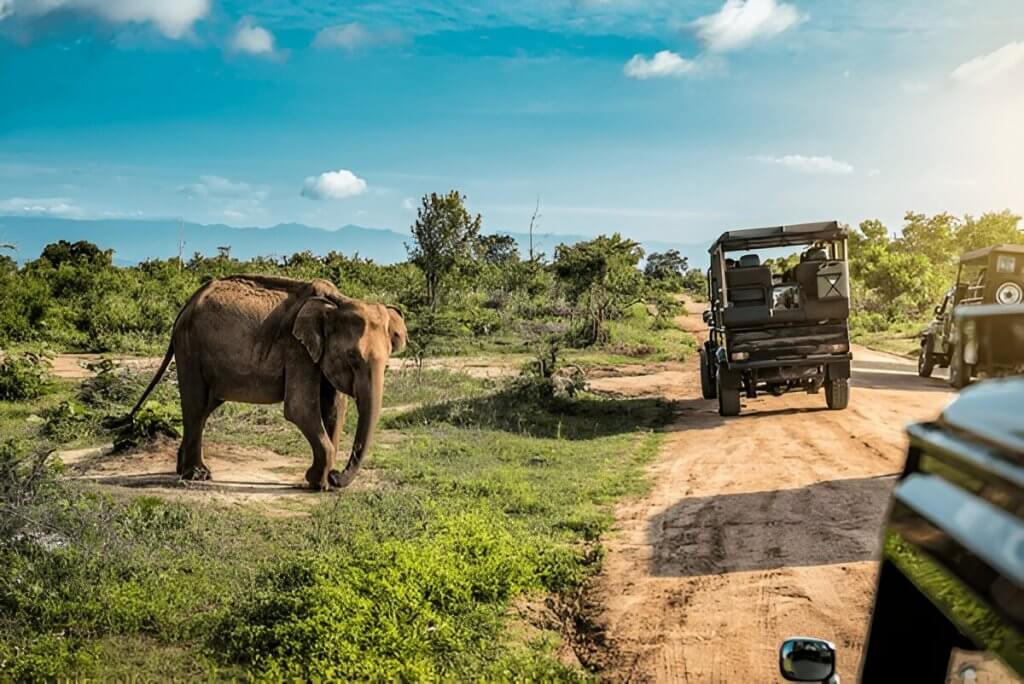
Wildlife Encounters in Sri Lanka’s Most Famous Park
Yala National Park, located in the southeast corner of the island, is undoubtedly Sri Lanka’s most visited and celebrated wildlife sanctuary. Spanning over 979 square kilometers across five blocks (though only two are currently open to tourists), Yala features a diverse landscape of light forests, scrubs, grasslands, lagoons, and rocky outcrops.
The park’s fame stems primarily from having one of the highest leopard densities in the world. But there’s much more to Yala than just leopards. The park is home to 44 mammal species and 215 bird species. During a typical safari, you might encounter elephants, sloth bears, jackals, spotted deer, sambar, wild boar, and numerous crocodiles lounging by the waterholes.
What makes Yala truly special is the unique ecosystem where forest meets coast. The southern boundary of the park stretches along the Indian Ocean, creating spectacular scenery where wildlife roams against a backdrop of pristine beaches and dunes.
Tracking the Elusive Sri Lankan Leopard
The Sri Lankan leopard (Panthera pardus kotiya) is a subspecies endemic to the island. Larger and darker than its mainland cousins, these magnificent cats have adapted perfectly to Yala’s terrain. With an estimated 35-40 leopards in Block 1 alone, this is your best chance in Sri Lanka—and possibly in all of Asia—to spot one in the wild.
Early morning and late afternoon are the prime times for leopard sightings, as they often drape themselves over tree branches or rock outcroppings to rest during these cooler hours. The best spots include the areas around Sithulpawwa Rock and the many watering holes throughout Block 1.
When tracking leopards, patience is key. Listen to your guide’s advice and scan the landscapes carefully. Sometimes, alarm calls from deer or monkeys can alert you to a predator’s presence long before you spot it.
Best Time to Visit and Safari Experience
While Yala National Park is open year-round (except for a brief closure in September-October for maintenance), the best wildlife viewing happens during the dry season from May to August. During this period, animals congregate around water sources, making them easier to spot.
A typical safari involves a 3-4 hour jeep ride through the park, either in the early morning (5:30-9:30 AM) or afternoon (3:00-6:30 PM). I strongly recommend the morning safari for better wildlife activity and softer light for photography. Consider booking a full-day safari if you’re serious about wildlife watching, as it gives you access to less crowded areas and increases your chances of significant sightings.
Entry fees cost around $15 per person plus additional vehicle charges. Hiring a knowledgeable guide is absolutely worth the extra cost—they know where animals were spotted recently and can identify countless birds and plants you might otherwise miss.
2-Day Yala National Park Trip from Colombo offers the perfect wildlife escape with comfortable overnight accommodation near Sri Lanka’s most famous national park. You’ll enjoy multiple safari opportunities to spot the legendary Sri Lankan leopard, elephants, and diverse wildlife while experiencing the park’s varied ecosystems from coastal lagoons to dense forests.
How to Get to Yala National Park:
- Nearest Town: Tissamaharama (15km)
- Distance from Colombo: 300km (6-7 hours)
- Best Way to Travel: Private car/taxi or bus to Tissamaharama, then tuk-tuk to park entrance
2) Wilpattu National Park
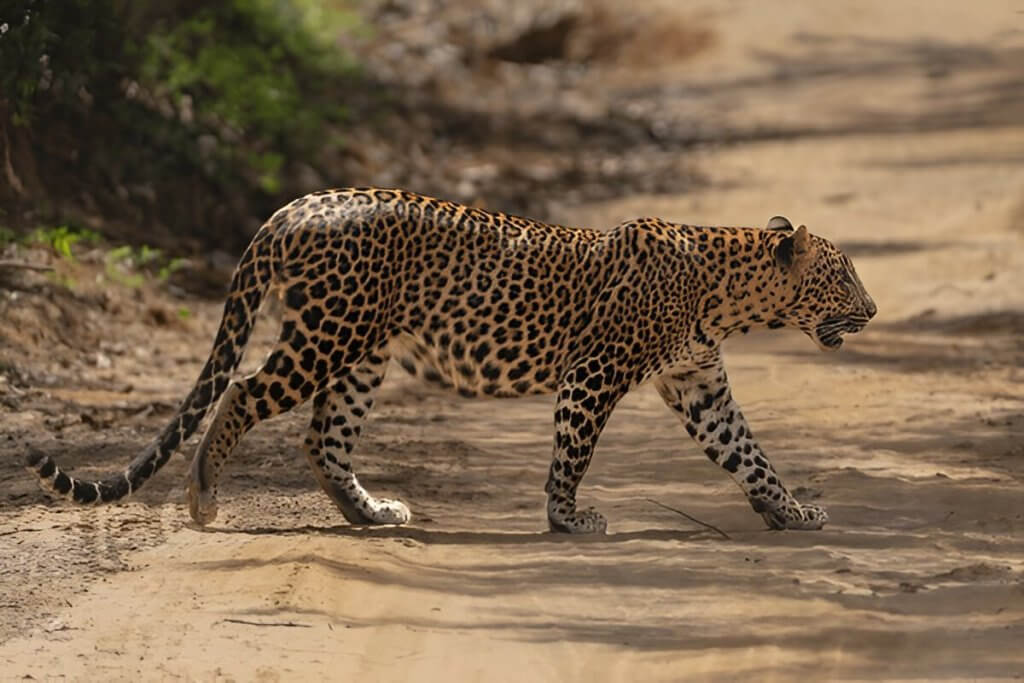
Sri Lanka’s Largest National Park
Wilpattu, whose name means “Land of Lakes,” is Sri Lanka’s largest national park, covering an impressive 1,317 square kilometers in the northwest of the island. Less crowded than Yala, Wilpattu offers a more serene safari experience without compromising on wildlife encounters.
Wilpattu National Park reopened to tourists in 2010 after being closed for nearly 30 years due to civil conflict, and it’s steadily gaining popularity among wildlife enthusiasts seeking authentic experiences away from the tourist crowds.
What makes Wilpattu unique is its network of over 50 natural lakes or “villus”—sand-rimmed natural basins that fill with rainwater. These villus create a distinctive landscape and serve as critical water sources for the park’s diverse inhabitants.
Unique Lake Ecosystem and Wildlife Viewing
The villus form the centerpiece of Wilpattu’s ecosystem, attracting all manner of wildlife, especially during dry periods. The park is home to an impressive array of animals, including leopards, elephants, sloth bears, spotted deer, mongoose, and wild boar.
Wilpattu also boasts a higher chance of spotting the elusive sloth bear compared to other parks. These shaggy omnivores can often be seen foraging for termites or fruits, especially around dawn and dusk.
Bird life around the villus is spectacular, with painted storks, open-billed storks, and many species of eagles regularly sighted. The park’s diverse habitats support over 200 bird species, making it a paradise for birdwatchers.
The best time to visit Wilpattu is from February to October, with May to August being ideal for wildlife viewing as animals gather around the shrinking water sources. The park’s extensive size means you’ll need more time to explore properly—I recommend planning at least two full days of safaris to appreciate its diversity.
Unlike Yala, Wilpattu offers a greater sense of wilderness and exploration. The roads are less developed, and the vegetation is denser, creating an adventurous atmosphere as you search for wildlife among the thick forests and open plains surrounding the villus.
Wilpattu Wildlife Safari with Breakfast and Picnic Lunch start from Anuradhapura offers a full-day leopard and elephant spotting adventure in Sri Lanka’s largest national park, featuring scenic lake ecosystems, delicious outdoor dining, and exclusive wildlife encounters away from crowded tourist areas.
How to Get to Wilpattu National Park:
- Nearest Town: Puttalam (26km)
- Distance from Colombo: 180km (4-5 hours)
- Best Way to Travel: Private vehicle via Chilaw or public bus to Puttalam, then taxi to park
3) Udawalawe National Park
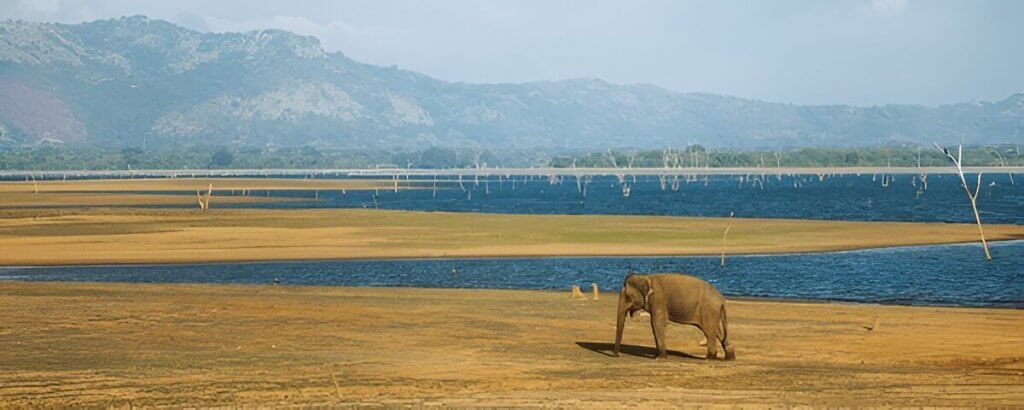
Elephant Haven of Sri Lanka
If elephants top your wildlife wish list, Udawalawe National Park should be your priority destination in Sri Lanka. Established in 1972 primarily to protect the watershed of the massive Udawalawe Reservoir, this park has become renowned for its impressive elephant population, estimated at around 500-600 individuals.
Covering 308 square kilometers of mainly grasslands and bush forest, Udawalawe offers unparalleled elephant-watching opportunities. Unlike in denser parks, the open terrain here makes wildlife spotting relatively easy, with elephants visible year-round.
What makes Udawalawe special is not just the number of elephants but the consistency of sightings. While other parks might offer seasonal elephant gatherings, Udawalawe provides virtually guaranteed elephant encounters any time of year. You’ll often see family groups with adorable calves, solitary bulls, and sometimes impressive gatherings around water sources.
Conservation Efforts and Elephant Transit Home
Adjacent to the park is the Elephant Transit Home, a rehabilitation center for orphaned elephant calves. Established in 1995, the center cares for young elephants until they can be released back into the wild. Unlike some elephant facilities in Asia, the Transit Home minimizes human contact to ensure successful reintegration into wild herds.
Visitors can watch the baby elephants during their feeding times (9 AM, 12 PM, 3 PM, and 6 PM), which provides both entertainment and education about elephant conservation. The center has successfully rehabilitated and released over 100 elephants back into the wild, making it an important component of Sri Lanka’s elephant conservation efforts.
Beyond elephants, Udawalawe supports a variety of other wildlife, including water buffalo, sambar deer, monkeys, jackals, and even the occasional leopard. The park is also excellent for bird watching, with around 200 species including raptors like the white-bellied sea eagle and the changeable hawk-eagle.
The best times to visit are early morning or late afternoon when animals are most active. The park is accessible year-round, though the dry season (May to September) concentrates wildlife around water sources. A typical safari lasts 3-4 hours, and the park’s relatively compact size means you can cover significant ground in a single visit.
Udawalawe Safari Day Tour from Colombo combines the half-day safari experience with convenient round-trip transportation from Colombo, including a visit to the Elephant Transit Home. This full-day excursion (10-12 hours total) allows you to witness elephant rehabilitation efforts and enjoy a comprehensive wildlife experience without overnight accommodation.
How to Get to Udawalawe National Park:
- Nearest Town: Embilipitiya (20km)
- Distance from Colombo: 200km (4-5 hours)
- Best Way to Travel: Private car via Ratnapura or bus to Embilipitiya, then local transport
4) Minneriya National Park
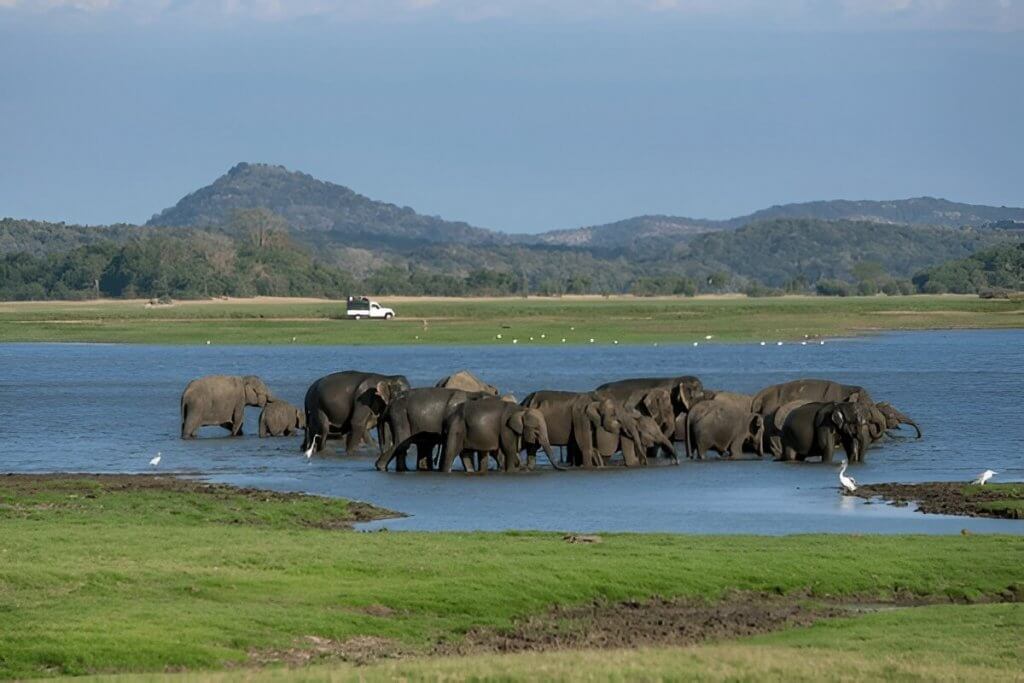
Witness ‘The Gathering’ – A Spectacular Elephant Assembly
Minneriya National Park, located in Sri Lanka’s North Central Province, may not be the largest protected area on the island at just about 88 square kilometers, but it hosts one of Asia’s most spectacular wildlife events: ‘The Gathering.’ During the dry season (July to October), hundreds of elephants – sometimes 300 or more – converge on the shores of the ancient Minneriya Tank (reservoir) in what is considered the largest known meeting of Asian elephants anywhere in the world.
As surrounding water sources dry up, elephants travel from far and wide to take advantage of the receding water levels, which expose fresh grass growth along the tank’s edges. This natural phenomenon creates an awe-inspiring wildlife spectacle where you can witness herds of elephants feeding, bathing, and socializing against the backdrop of the ancient reservoir.
The tank itself dates back to the 3rd century AD when it was built by King Mahasena. This historic irrigation marvel still serves local farmers while creating a lifeline for wildlife during drought periods.
Birding Paradise Around the Ancient Reservoir
Beyond elephants, Minneriya is a haven for water birds and raptors. The tank attracts numerous species including painted storks, great white pelicans, and various herons and egrets. Lucky visitors might spot the rare spot-billed pelican or gray-headed fish eagle.
The diverse habitat surrounding the tank supports other wildlife including sambar and spotted deer, macaques, langur monkeys, and the elusive Sri Lankan leopard. Crocodiles and water buffalo are commonly seen near the water’s edge.
A unique aspect of Minneriya is its connection to two nearby national parks—Kaudulla and Wasgamuwa. Together they form part of an elephant corridor, allowing these magnificent creatures to move between protected areas according to seasonal changes. Some wildlife enthusiasts visit all three parks to gain a comprehensive understanding of elephant movements and behavior in the region.
For the best experience, plan your visit during the height of The Gathering in August and September. Morning and evening safaris are available, with the latter often providing the most dramatic scenery as elephants are silhouetted against the setting sun reflected in the tank’s waters.
Sigiriya & Dambulla Tour with Minneriya Safari combines Sri Lanka’s ancient heritage with incredible wildlife in one day. You’ll explore the iconic Sigiriya Rock Fortress and historic Dambulla Cave Temple, then experience a thrilling jeep safari in Minneriya National Park to witness the famous elephant gathering around the ancient reservoir.
How to Get to Udawalawe National Park:
- Nearest Town: Habarane (25km)
- Distance from Colombo: 200km (4.5 hours)
- Best Way to Travel: Private vehicle or train to Habarane, then taxi/tuk-tuk to park entrance
5) Horton Plains National Park
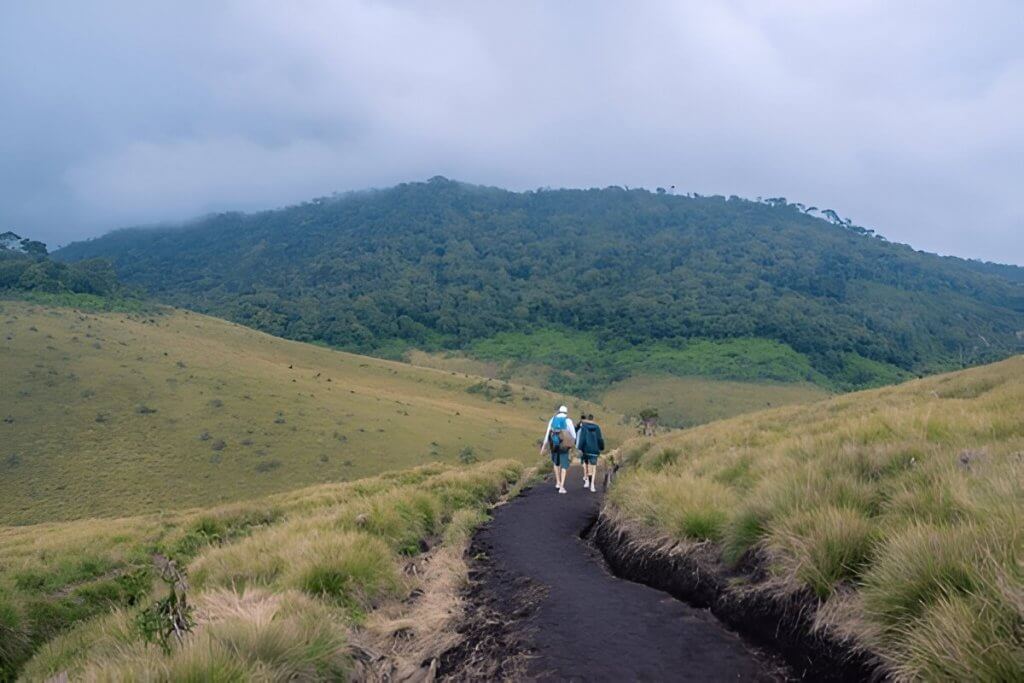
Cloud Forests and Endemic Flora
Shifting dramatically from the lowland parks, Horton Plains National Park offers an entirely different ecosystem and experience. Located in Sri Lanka’s central highlands at an elevation of over 2,100 meters, this misty plateau is one of the island’s most important watershed areas and a UNESCO World Heritage Site.
Unlike other national parks where safaris are conducted by vehicle, Horton Plains is explored on foot along well-marked hiking trails. The park covers 31.6 square kilometers of montane cloud forest and wet grassland, home to an extraordinary concentration of endemic species adapted to the cool, damp conditions.
The flora here is particularly special, with over 750 plant species, including 54 woody plants found nowhere else on Earth. During my visits, I’ve been mesmerized by the twisted, moss-covered trees draped in lichen, colorful orchids, and the vibrant rhododendrons that bloom between April and September.
This unique ecosystem supports specialized wildlife too. Though you won’t see elephants here, the park is home to endemic highland species including the purple-faced langur, stripe-necked mongoose, and if you’re exceptionally lucky, the Sri Lankan leopard. More commonly spotted are sambar deer that often graze peacefully in the grasslands.
World’s End and Baker’s Falls Hiking Experience
The park’s most famous attraction is the stunning viewpoint known as World’s End, where the plateau comes to an abrupt halt with a sheer cliff dropping almost 880 meters. On clear mornings, the views extend across the southern plains all the way to the ocean. Nearby, the equally impressive Little World’s End offers another spectacular vantage point with a 300-meter drop.
The popular circular hiking trail (9 kilometers) takes you through diverse habitats to both viewpoints and the beautiful Baker’s Falls, a 20-meter cascade surrounded by pristine cloud forest. The entire loop typically takes 3-4 hours at a leisurely pace, allowing time for photography and wildlife watching.
For the best experience, arrive early—the park opens at 6:00 AM, and morning offers the clearest views before clouds roll in. By 10 AM, World’s End is often obscured by mist. The park’s high elevation means cool temperatures year-round, with frost common between January and March. Always bring warm layers, rain protection, and sun protection, as weather can change rapidly.
Horton Plains provides a refreshing contrast to the hot lowland parks and offers serious hikers an opportunity to experience Sri Lanka’s fascinating highland ecology up close.
Horton Plains and Pedro Tea Factory Tour from Nuwara Eliya combines breathtaking highland wilderness hiking to World’s End cliff viewpoint with an authentic Ceylon tea plantation experience, showcasing Sri Lanka’s stunning mountain landscapes and world-famous tea heritage in one unforgettable day.
How to Get to Horton Plains National Park:
- Nearest Town: Nuwara Eliya (32km)
- Distance from Colombo: 180km (5-6 hours)
- Best Way to Travel: Private 4WD vehicle essential due to mountain roads; public transport not recommended
6) Bundala National Park
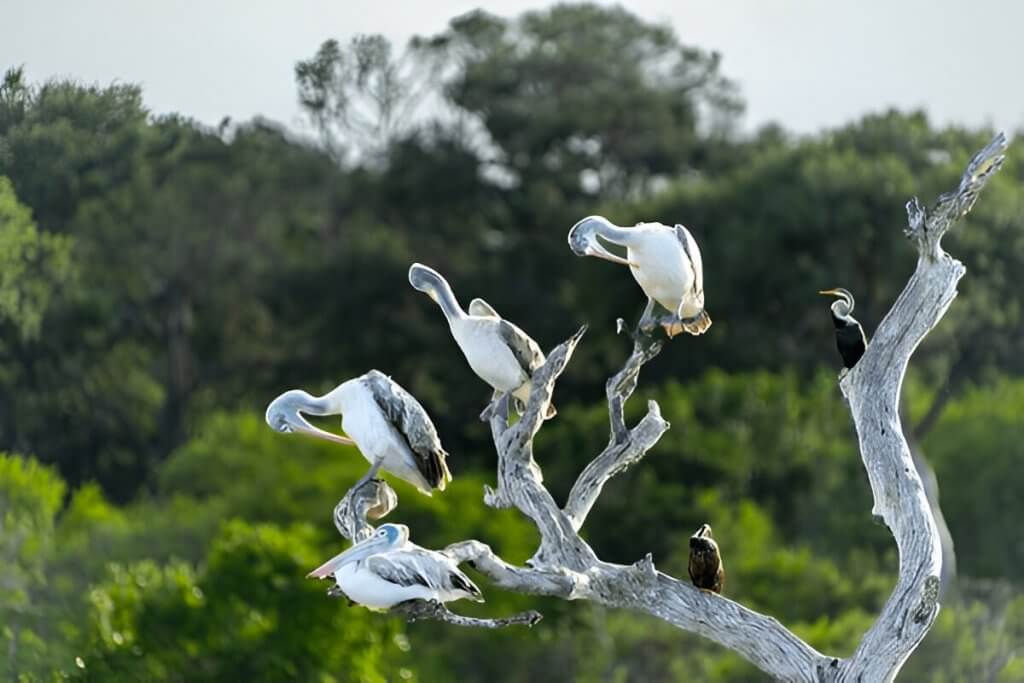
Ramsar Wetland and Migratory Bird Sanctuary
Bundala National Park, located along Sri Lanka’s southeastern coast, offers yet another distinct ecosystem in our tour of the island’s diverse protected areas. Designated as Sri Lanka’s first Ramsar Wetland of International Importance, this coastal park spans 62 square kilometers of lagoons, dunes, and scrubland.
While Bundala doesn’t receive the same attention as nearby Yala, it offers something special for wildlife enthusiasts—particularly birdwatchers. The park protects an intricate network of brackish lagoons that serve as critical habitat for both resident and migratory birds.
During the northern hemisphere winter (October to March), Bundala becomes a haven for thousands of migratory birds escaping colder climates. The park regularly hosts over 200 bird species, including the greater flamingo, which can sometimes be seen in flocks of hundreds, creating a spectacular pink display against the blue lagoons.
Other notable birds include painted storks, black-necked storks, Eurasian spoonbills, and various plovers, sandpipers, and other waders. For serious birders, Bundala offers the chance to spot rarities like the great thick-knee, black bittern, and Eurasian oystercatcher.
Coastal Biodiversity and Turtle Nesting Sites
Beyond birds, Bundala’s varied habitats support impressive biodiversity. The park is home to around 32 mammal species, including elephants, water buffalo, spotted deer, and occasionally leopards. Reptiles are also well-represented, with mugger crocodiles often seen basking along the edges of lagoons.
One of Bundala’s special features is its beaches, which serve as important nesting sites for marine turtles. Five of the world’s seven marine turtle species visit these shores to lay eggs, including the leatherback, green, loggerhead, hawksbill, and olive ridley turtles.
The best time to visit Bundala is during the migratory season from November to March when bird populations are at their peak. Early morning safaris are most rewarding, but unlike some other parks, Bundala can also offer excellent wildlife viewing throughout the day around the lagoons.
Safari jeeps are available from nearby towns like Tissamaharama and Hambantota, and the less crowded nature of Bundala means a more peaceful experience than in neighboring Yala. For photography enthusiasts, the combination of waterbirds, golden light, and reflective lagoons creates perfect conditions for stunning images.
Morning Safari at Bundala National Park offers optimal bird watching conditions with cooler temperatures, active wildlife, and stunning sunrise photography opportunities over the coastal lagoons, making it ideal for serious birders and photographers seeking the best lighting and animal activity.
Afternoon Safari at Bundala National Park provides convenient timing for travelers combining it with other activities, featuring beautiful sunset reflections on the water and good flamingo viewing, though wildlife activity may be reduced during hotter midday temperatures.
Pros: Morning safaris deliver peak bird activity and cooler weather; afternoon safaris offer flexible scheduling and spectacular sunset scenery over wetlands.
Cons: Morning tours require very early starts (5:30 AM); afternoon safaris face reduced wildlife activity and intense heat during peak hours.
How to Get to Bundala National Park:
- Nearest Town: Hambantota (20km)
- Distance from Colombo: 270km (5-6 hours)
- Best Way to Travel: Private car or bus to Hambantota, then taxi to park entrance
7) Wasgamuwa National Park
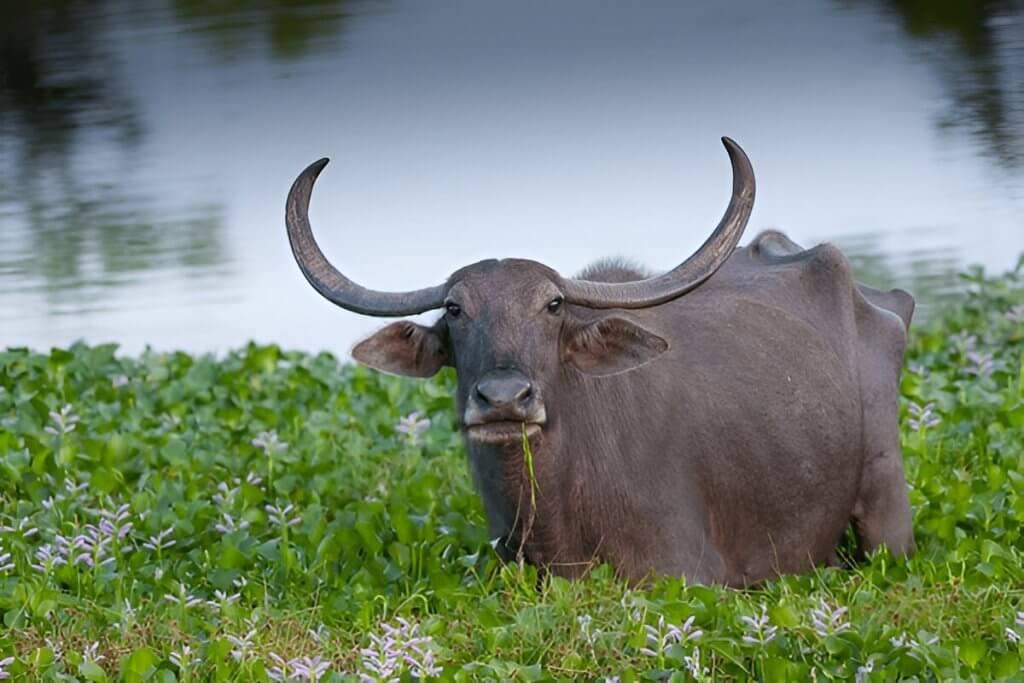
Off the Beaten Path Wildlife Experiences
Moving away from the tourist hotspots, Wasgamuwa National Park offers an authentic wilderness experience in Sri Lanka’s north-central region. Established in 1984 and covering 393 square kilometers, this park remains relatively undiscovered by international tourists, making it perfect for travelers seeking solitude and untamed nature.
The name “Wasgamuwa” derives from the Sinhalese words “Walas” (bear) and “Gamuwa” (woods), indicating the park’s significance as a habitat for sloth bears. Indeed, Wasgamuwa offers some of the best opportunities in Sri Lanka to observe these elusive creatures, particularly during the fruiting season of palu trees (June to July).
The park’s landscape features dense dry-zone forests interspersed with grasslands and wetlands created by the Mahaweli and Amban rivers that border the park. This mosaic of habitats supports a healthy elephant population estimated at 150-200 individuals. These elephants are known for their unique behavior—many male elephants here have never developed tusks, a trait that possibly evolved during colonial hunting periods when tuskers were selectively targeted.
Besides elephants and sloth bears, Wasgamuwa hosts leopards, water buffalo, purple-faced langurs, toque macaques, and various deer species. Bird life is abundant too, with over 140 species including endemic ones like the Sri Lanka junglefowl and Sri Lanka spurfowl.
Ancient Ruins and Cultural Heritage Within the Park
What sets Wasgamuwa apart from many other Sri Lankan national parks is its rich archaeological heritage. The park contains several ancient ruins dating back to the Kingdom of Polonnaruwa (11th-13th centuries). Most notable is the ancient stone bridge at Kalinga Yoda Ela, believed to be constructed during King Parakramabahu’s reign.
Throughout the park, you’ll find evidence of ancient irrigation systems, stone pillars, and religious monuments partially reclaimed by jungle. These ruins add a fascinating cultural dimension to your wildlife safari, telling stories of the island’s ancient civilization.
The best time to visit Wasgamuwa is during the dry season from May to September when wildlife congregates around remaining water sources. The park receives fewer visitors than Yala or Udawalawe, meaning your safari experience will be more exclusive and peaceful.
Access is typically from nearby towns like Polonnaruwa or Dambulla, and accommodation options are more limited than at more popular parks. However, several eco-friendly lodges and basic accommodations have developed around the park boundaries in recent years.
How to Get to Wasgamuwa National Park:
- Nearest Town: Polonnaruwa (50km)
- Distance from Colombo: 230km (5 hours)
- Best Way to Travel: Private vehicle or bus to Polonnaruwa, then taxi/arranged transport to park
8) Gal Oya National Park
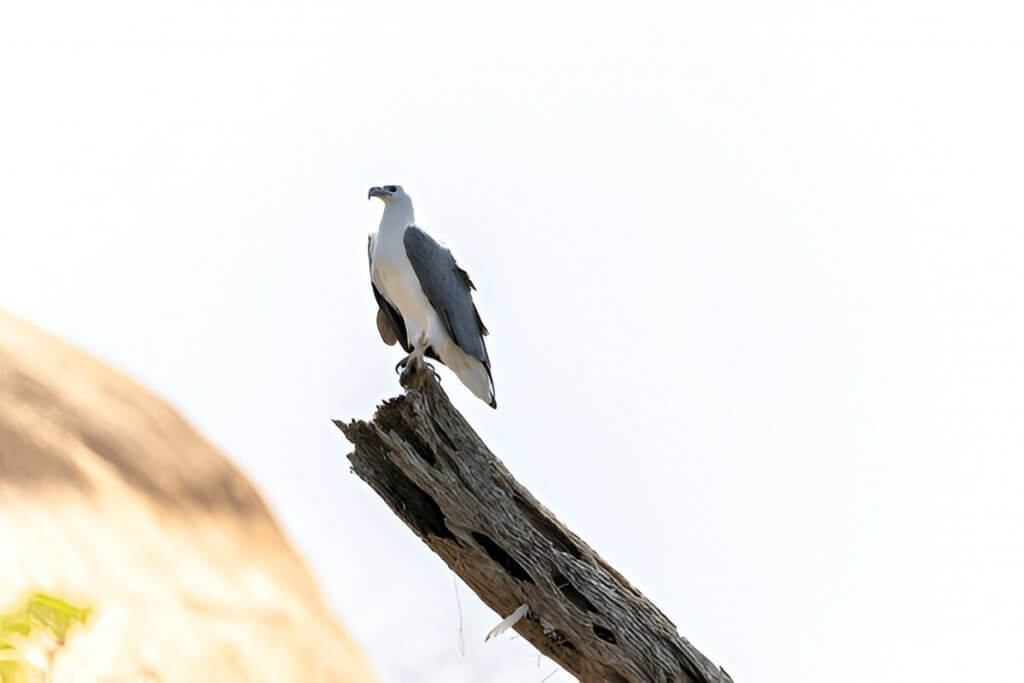
Sri Lanka’s Boat Safari Experience
Gal Oya National Park offers perhaps the most unique wildlife viewing experience in Sri Lanka through its boat safaris on the massive Senanayake Samudraya reservoir. Established in 1954, this park protects 259 square kilometers of forest and water habitats in the island’s eastern region.
The centerpiece of Gal Oya is Sri Lanka’s largest reservoir, created by damming the Gal Oya river. This vast inland water body creates a distinctive ecosystem where you can observe wildlife from the water—a refreshing change from the conventional jeep safaris offered elsewhere.
During boat safaris, you might witness elephants swimming between islands or bathing along the shoreline—one of wildlife watching’s most magical sights. The reservoir contains numerous islands, including the country’s largest inland island, Kurukkal Madam, which becomes a sanctuary for wildlife, especially during dry periods.
Beyond elephants, the park supports leopards, sloth bears, water buffalo, and four species of deer. The wetland environment also attracts abundant birdlife, including white-bellied sea eagles that nest in tall trees overlooking the water.
The boat safaris typically last 2-3 hours and are best undertaken in early morning when the water is calm and wildlife is active along the shorelines. Traditional jeep safaris are also available to explore the park’s forested areas away from the reservoir.
Indigenous Vedda Community Connection
One of Gal Oya’s unique cultural aspects is its connection to Sri Lanka’s indigenous Vedda people. The park and surrounding areas are the traditional homeland of East Coast Vedda communities who have lived in harmony with the forest for thousands of years.
Some tourism initiatives in the region offer opportunities to connect with Vedda elders for forest walks, learning about traditional medicines, wild food gathering, and understanding their deep spiritual connection to the land. These cultural interactions provide valuable insight into sustainable living practices and an ancient relationship with nature that predates modern Sri Lankan civilization.
The best time to visit Gal Oya is from March to July when water levels in the reservoir are lower, concentrating wildlife on and around the islands. The park’s remote location—about 4 hours from Kandy—means it receives significantly fewer visitors than more accessible parks, resulting in a more exclusive experience.
Accommodation options have improved in recent years, with Gal Oya Lodge offering an eco-luxury experience that combines comfort with responsible tourism principles. The lodge works closely with local communities and conservation initiatives to ensure tourism benefits both wildlife and people.
How to Get to Gal Oya National Park:
- Nearest Town: Ampara (20km)
- Distance from Colombo: 350km (7-8 hours)
- Best Way to Travel: Private car recommended; bus to Ampara then taxi, or fly to Batticaloa (1 hour drive)
9) Kumana National Park
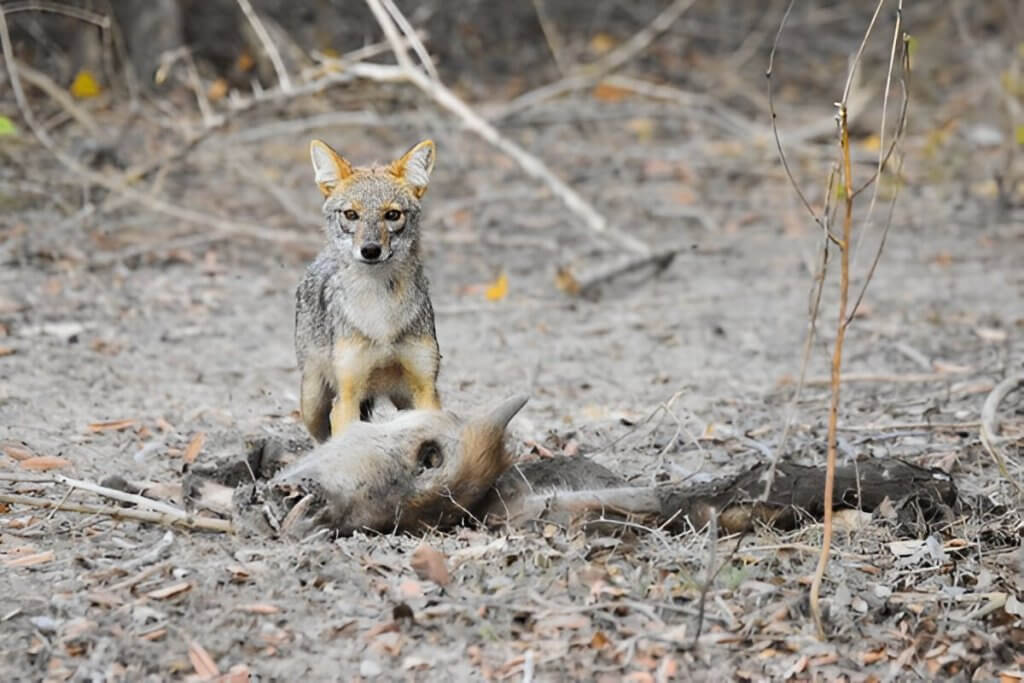
Bird Watcher’s Paradise
Formerly known as Yala East, Kumana National Park covers 357 square kilometers along Sri Lanka’s southeastern coast. While less famous than its neighbor Yala, Kumana offers spectacular birdwatching opportunities centered around the 200-hectare Kumana Villu—a mangrove swamp lake fed by the Kumbukkan Oya River.
This wetland system serves as a crucial breeding ground for countless water birds, making Kumana one of Sri Lanka’s most important bird sanctuaries. During the April-July nesting season, the villu hosts thousands of migratory and resident birds, creating one of the most impressive avian spectacles in South Asia.
Visitors can observe rare species like the black-necked stork, lesser adjutant, Eurasian spoonbill, and great thick-knee. The painted stork, pelican, and large egret colonies are particularly impressive, with hundreds of nests dotting the trees that emerge from the swamp. In total, over 255 bird species have been recorded within the park.
While birds are the star attraction, Kumana also supports healthy populations of mammals including elephants, leopards, and sloth bears. The park’s varied landscape of lagoons, mangroves, and forests creates diverse habitats supporting rich biodiversity.
Connection to Yala and Extended Safari Options
Kumana’s proximity to Yala National Park creates interesting opportunities for extended wildlife explorations. Some specialized tour operators offer camping safaris that traverse both parks, providing a comprehensive experience of Sri Lanka’s southeastern wilderness.
An advantage of visiting Kumana is the significantly smaller number of tourists compared to neighboring Yala. This means more peaceful wildlife viewing and often more attentive guides who can focus on showing you the park’s specialties rather than rushing between popular viewing spots.
The park is typically accessed from Arugam Bay or Potuvil towns. The journey to the park entrance itself passes through beautiful countryside and traditional villages, adding cultural interest to your wildlife adventure.
For photography enthusiasts, Kumana offers exceptional opportunities. The combination of wetlands, dry forests, and coastal habitats creates diverse backdrops for wildlife images. The bird colonies in particular allow for frame-filling shots of nesting behaviors and interactions rarely seen elsewhere.
The best months to visit are May to June when water birds gather in large numbers for nesting. However, the park offers good wildlife viewing year-round, with elephant sightings particularly common during the drier months.
How to Get to Kumana National Park:
- Nearest Town: Arugam Bay (45km)
- Distance from Colombo: 320km (7-8 hours)
- Best Way to Travel: Private vehicle via Monaragala or bus to Arugam Bay, then arranged safari transport
10) Maduru Oya National Park
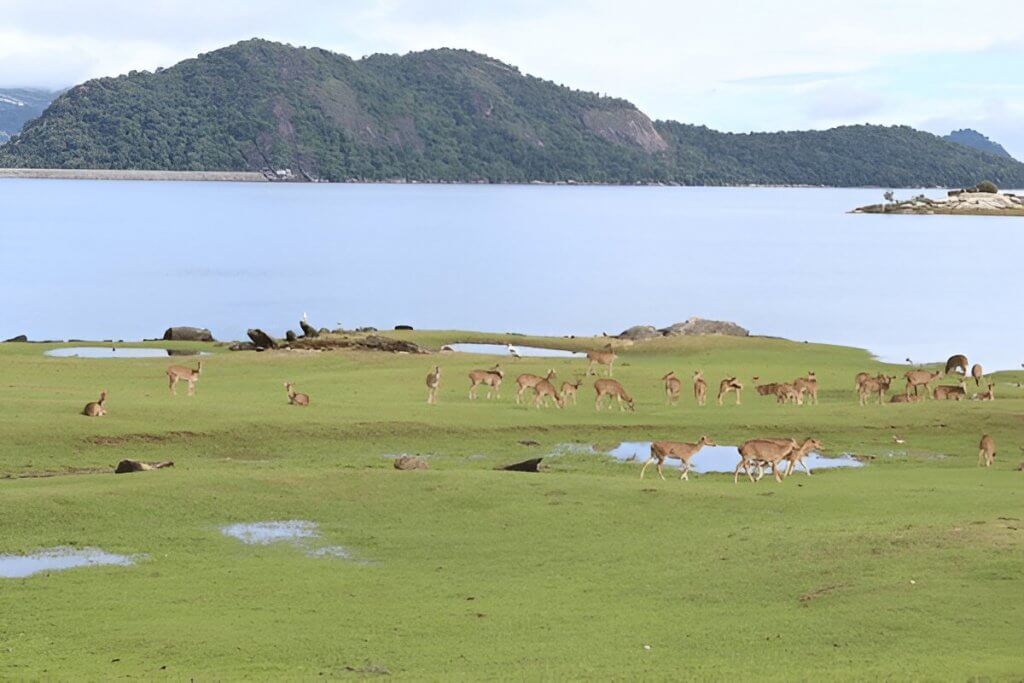
Protecting Watersheds and Wildlife
Completing our exploration of Sri Lanka’s top national parks, Maduru Oya protects 58,850 hectares in the eastern part of the island. Established in 1983, the park serves as a critical watershed protection area for five reservoirs, including the massive Maduru Oya reservoir that gives the park its name.
The landscape features distinctive quartz outcrops rising from gently undulating plains covered with dry-zone forest and savanna-like grasslands. These ancient rock formations, some dating back 500 million years, create a dramatic backdrop for wildlife viewing and are themselves of significant geological interest.
Maduru Oya is part of the Mahaweli Development Project and forms an important link in the protected area network created to provide refuges for wildlife displaced by large-scale irrigation and hydropower developments. The park connects with elephant corridors allowing these wide-ranging animals to move between protected areas.
The elephant population here exhibits interesting behaviors adapted to the park’s specific ecology. During dry periods, elephants often dig holes in dry river beds to access underground water, displaying remarkable intelligence and adaptation. Other mammals in the park include leopard, sloth bear, sambar, spotted deer, and buffalo.
Remote Wilderness Adventure
What makes Maduru Oya special is its relative remoteness and pristine nature. Far from the tourist circuit of southern parks, visitors here experience a true wilderness with minimal infrastructure and development. This remoteness has preserved traditional ecological relationships and natural behaviors sometimes affected by tourism pressure in more visited parks.
The park’s large size and varied terrain make it ideal for adventurous travelers seeking extended safari experiences. Multi-day camping trips can be arranged through specialized operators, allowing for dawn-to-dusk wildlife observation and night camping surrounded by the sounds of the forest.
Birdwatchers will appreciate the park’s 150+ species, including endemics like the Sri Lanka junglefowl and rare migrants. The reservoirs and tanks attract numerous aquatic birds, while the forests support typical dry-zone species.
Access to Maduru Oya is usually from the town of Ampara, and accommodation options are limited compared to more developed tourism areas. However, this limitation is part of the authentic experience that makes visiting worthwhile for true nature enthusiasts.
The best time to visit is during the dry season from May to September when wildlife concentrates around remaining water sources. However, the park’s monsoon season (November to December) brings its own beauty as the landscape transforms with lush vegetation and flowing streams.
How to Get to Maduru Oya National Park:
- Nearest Town: Ampara (35km)
- Distance from Colombo: 280km (6-7 hours)
- Best Way to Travel: Private car or bus to Ampara, then 4WD vehicle to park (rough roads)
Practical Guide to Visiting Sri Lanka’s National Parks
Best Seasons for Wildlife Viewing in Sri Lanka
Sri Lanka’s wildlife viewing opportunities vary throughout the year due to the island’s complex monsoon patterns. Generally, the dry season (May to September) provides the best wildlife viewing in most parks as animals gather around limited water sources. However, each park has its optimal visiting times:
- Yala and Bundala: Best from February to July when water levels are low
- Wilpattu: Optimal from February to October
- Udawalawe: Good year-round, but best from May to September
- Minneriya: The famous “Gathering” occurs from July to October
- Horton Plains: Visit early morning year-round, but December to April offers clearest views
- Kumana: Bird breeding season peaks from April to July
- Gal Oya: March to July when reservoir levels drop
- Wasgamuwa, Maduru Oya: May to September during the dry season
During the northeastern monsoon (December to March), parks in the Cultural Triangle area may experience rain, while the southwestern monsoon (May to September) affects parks in the south and west. Planning around these patterns maximizes your wildlife viewing potential.
Safari Options and Tour Operators
Several options exist for exploring Sri Lanka’s national parks:
- Half-day safaris: Most common option, typically 3-4 hours in morning or afternoon
- Full-day safaris: More comprehensive experience with lunch break in designated areas
- Multi-day camping safaris: Available in select parks like Yala, Wilpattu, and Wasgamuwa
- Specialized tours: Photography tours, bird watching expeditions, or research-focused trips
When selecting a tour operator, look for:
- Experienced naturalist guides with good English skills and wildlife knowledge
- Well-maintained vehicles with proper viewing capabilities
- Responsible wildlife viewing practices (maintaining proper distance, no off-road driving in sensitive areas)
- Positive reviews emphasizing educational aspects rather than just animal “sightings”
Reputable operators include Leopard Trails, Eco Team, Mahoora Tented Safari Camps, and Jetwing Eco Holidays. Prices vary significantly based on exclusivity and services, from $30 for basic half-day safaris to $200+ for premium experiences.
Photography Tips for Wildlife Enthusiasts
Sri Lanka offers exceptional wildlife photography opportunities. Here are some tips:
- Bring a versatile telephoto lens (at least 300mm, preferably 400-600mm)
- Consider a second body with a wide-angle lens for landscapes
- Use fast shutter speeds (1/1000 or faster) for animals in motion
- Morning and evening light provides the best conditions
- Request a proper photography vehicle with stabilizing beanbags or window mounts
- Learn about animal behavior to anticipate action moments
- Include environmental context in some shots to tell the story of the habitat
- Pack adequate memory cards, spare batteries, and dust protection
Many lodges now offer specialized photography safaris with adapted vehicles and guides who understand photographers’ needs.
Accommodation Options – From Luxury to Budget
Accommodation around Sri Lanka’s national parks has improved dramatically in recent years, with options including:
Luxury options:
- Leopard Trails (Yala, Wilpattu)
- Wild Coast Tented Lodge (Yala)
- Jetwing Yala
- Gal Oya Lodge
- Cinnamon Wild
Mid-range options:
- Mahoora Tented Safari Camps (multiple parks)
- Kalu’s Hideaway (Udawalawe)
- Elephas Resort (Minneriya/Kaudulla)
- Big Game Camp (Wilpattu)
Budget options:
- Safari Beach Hotel (Yala)
- Hotel Chandrika (Yala)
- Lake Side Cabanas (Udawalawe)
- Various guesthouses in Tissamaharama and other gateway towns
Booking accommodation well in advance is essential, especially during peak season (December-March). Many of the luxury and mid-range options include safari packages with expert guides, often providing a more comprehensive experience than arranging components separately.
Conservation Challenges and Responsible Tourism
Human-Wildlife Conflict Management
Despite their protected status, Sri Lanka’s national parks face significant conservation challenges. Human-wildlife conflict tops the list, particularly involving elephants. As natural habitats shrink and fragment, elephants increasingly raid crops in adjacent villages, leading to deadly confrontations. Approximately 70-80 elephants and 30-50 people die annually from these conflicts.
Conservation organizations are implementing various solutions:
- Electric fencing around villages (rather than parks)
- Early warning systems to alert villages of approaching elephants
- Alternative crop schemes less attractive to elephants
- Community-based guard systems
- Wildlife corridors connecting protected areas
Tourism revenue plays a crucial role in demonstrating the economic value of living wildlife and intact ecosystems. Parks that generate significant tourism income receive better protection and community support.
Another challenge is balancing tourism development with conservation. Popular parks like Yala face issues with overcrowding, especially around leopard sightings, which can stress animals and degrade habitats. Authorities are implementing measures like visitor caps, rotation systems for viewing areas, and stricter enforcement of safari vehicle regulations.
Poaching remains a concern in more remote parks, particularly for economically valuable species like pangolins and certain reptiles. Climate change also threatens park ecosystems, with changing rainfall patterns affecting water availability and plant communities.
How Tourists in Sri Lanka can Contribute to Conservation
As visitors to Sri Lanka’s national parks, we can make positive contributions to conservation efforts:
- Choose responsible operators: Select companies that follow ethical wildlife viewing practices and contribute to conservation initiatives or local communities.
- Report bad behavior: If you witness inappropriate actions by drivers or other tourists (like getting too close to animals or feeding wildlife), report it to park authorities.
- Reduce plastic waste: Bring reusable water bottles and avoid single-use plastics that may end up in park ecosystems.
- Respect park rules: Stay on designated roads, maintain appropriate distances from wildlife, and follow guide instructions.
- Support local communities: Purchase crafts, food, and services from communities around parks, creating economic incentives for conservation.
- Contribute to conservation organizations: Consider donating to reputable NGOs working on Sri Lankan wildlife protection, such as the Wildlife and Nature Protection Society of Sri Lanka or the Centre for Conservation and Research.
- Spread awareness: Share your experiences and the importance of conservation with others through social media and personal networks.
Remember that as tourists, our choices directly impact the future of these remarkable ecosystems. By practicing responsible tourism, we help ensure these national parks remain vibrant sanctuaries for generations to come.
Conclusion
Sri Lanka’s national parks showcase the extraordinary biodiversity compressed into this small island nation. From the leopard-rich scrublands of Yala to the misty cloud forests of Horton Plains, from Minneriya’s impressive elephant gatherings to Bundala’s bird-filled wetlands, each park offers distinctive experiences and ecosystems.
What makes Sri Lanka truly special for wildlife enthusiasts is the accessibility and diversity of experiences available within short distances. In few other countries can you observe elephants in the morning, hike cloud forests in the afternoon, and watch marine turtles nesting by evening—all within a day’s journey.
As development pressures and climate change intensify, these protected areas become increasingly vital refuges for Sri Lanka’s remarkable biodiversity. Tourism, when conducted responsibly, provides economic justification for their continued protection while creating unforgettable experiences for visitors.
Whether you’re a serious wildlife photographer, an avid birder, or simply someone who appreciates natural beauty, Sri Lanka’s national parks offer world-class encounters with some of our planet’s most fascinating creatures in settings of extraordinary beauty. By approaching these experiences with respect and awareness, we contribute to preserving these treasures for future generations.
FAQs About Sri Lanka’s National Parks
1. When is the best time of year to visit Sri Lanka’s national parks?
The ideal timing depends on which parks you want to visit. Generally, the dry season from May to September offers excellent wildlife viewing in most parks as animals concentrate around water sources. For specific parks, timing can be crucial—visit Minneriya between July and October to witness “The Gathering” of elephants, Kumana between April and July for peak bird breeding season, and Horton Plains early in the morning (before 10 AM) for clear views at World’s End.
2. Do I need to book national park safaris in advance?
Yes, especially during the high tourist season (December to March). Popular parks like Yala can become fully booked weeks in advance. For the best experience, arrange your safari jeep and guide at least a few days ahead through your accommodation or a reputable tour operator. This ensures you get experienced guides rather than whoever is available last-minute.
3. What should I pack for a Sri Lankan national park visit?
Essential items include:
- Neutral-colored clothing (avoid bright colors)
- Sun protection (hat, sunscreen, sunglasses)
- Insect repellent
- Binoculars
- Camera with telephoto lens if possible
- Refillable water bottle
- Light rain jacket (weather can change quickly)
- Small backpack for personal items
- Cash for park fees and tips
For Horton Plains, add warm layers as mornings can be quite cold.
4. Is it possible to see leopards in Sri Lanka’s national parks?
Yes, Sri Lanka offers some of the best leopard-watching opportunities in Asia. Yala National Park has the highest leopard density in the world, giving visitors a realistic chance of sightings, especially during early morning or late afternoon safaris. Wilpattu National Park also offers good leopard sightings, though the denser vegetation makes spotting them more challenging. Multiple-day safaris significantly increase your chances.
5. Are Sri Lanka’s national parks suitable for children?
Most Sri Lankan national parks are family-friendly, though some considerations apply. Parks like Udawalawe and Minneriya, with reliable elephant sightings and shorter safari durations (3-4 hours), work well for families with younger children. Horton Plains requires moderate hiking ability. For all parks, early morning safaris might be challenging for very young children, so afternoon safaris may be preferable. Many lodges offer child-friendly accommodations and some have junior naturalist programs to engage young wildlife enthusiasts.

